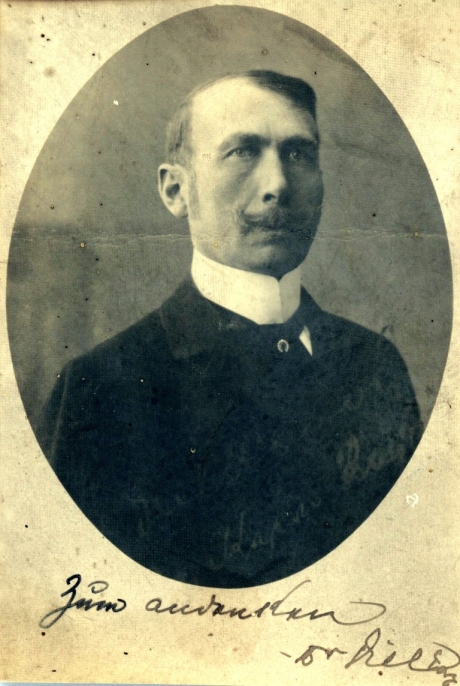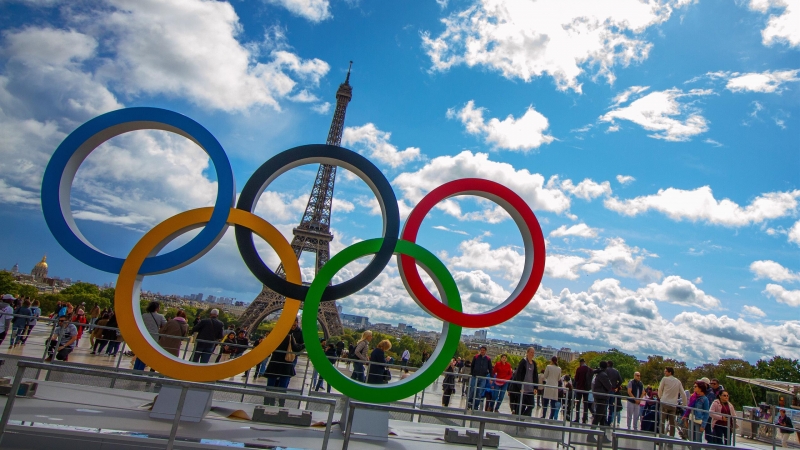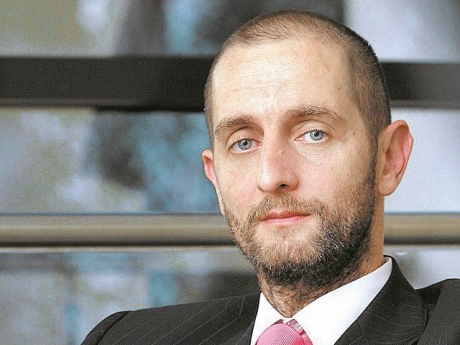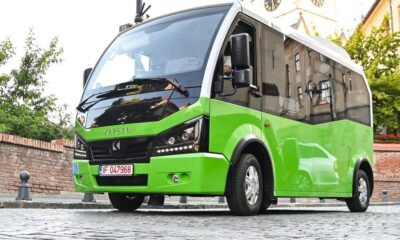NATIONAL
Karl Diel, Jimbolia surgeon devoted to community in which he was born
Publicat
acum 2 aniin
De
admin

Karl Diel chose to be a surgeon in a small Swabian locality at the edge of the Austro-Hungarian Empire – Jimbolia, although he graduated the Medical School in Budapest with the maximum grade and could practice in any European capital. He could become a craftsman in his father’s workshop or the owner of the Swabian Diel family’s estate, but fate chose for Karl not to be the firstborn of the house, the one who usually took over the administration of the inheritance to maintain it intact, so that his fortune would be education.
Karl Diel remained faithful all his life to the community in which he was born, becoming one of the most famous surgeons in historical Banat, whose notoriety spread well beyond Budapest, where his patients came from.
He had gained the trust of the people as a good specialist, because of the more than 50,000 interventions and surgeries, over 98 percent were completed successfully, but also because he was generous with the poor.
He worked alongside the “father” of Romanian neurosurgery, Dr. Bagdasar, married the daughter of the Vienna Court physician, would become the father-in-law of famous academician Pius Branzeu, whom he treated when a child, but he felt best in the multiethnic and multicultural town of Jimbolia, where four languages were spoken: Romanian, German, Hungarian, and Serbian, and where he lived until his death.
Museographer Cristina Dema and Sergiu Dema, director of the Jimbolia House of Culture, told AGERPRES that Dr. Karl Diel was so loved and appreciated by the locals that shortly after his death they erected a monument dedicated to him in the city center and which has remained untouched to this day, and the City Hospital which he founded bears his name.
The house where the doctor was born still exists today, becoming the Dr. Karl Diel Memorial House in Jimbolia.
“The memorial house of Dr. Karl Diel is very important not only for Jimbolia, but for the whole of south-western Banat. Karl Diel was born in Jimbolia on February 14, 1855, to a Swabian family. At that time, most Jimbolians were farmers, industrialists, and craftsmen. His father was a craftsman and had a clothes dyeing shop. Karl was the fifth child in the family, which was a good thing for him because the family was focused on sending him to school. In a family of farmers, by custom, the Swabians had their firstborn receive the family inheritance, the agricultural land, which they did not want to share. So did the craftsmen; had he been the firstborn of the family, he would have become a fabric dyer. As such, he was sent to school, studied medicine in Budapest with famous professors at the time, with one of them being named the ‘father’ of Hungarian orthopedics, who greatly appreciated Diel and offered him a leadership position at the hospital in Budapest, considering him his right hand. However, Diel resolutely decides to return to Jimbolia, a town where there was no hospital. Everyone was wondering why such a talented man, with a seemingly illustrious future in Hungary and maybe even in the whole of Austria-Hungary, gives up this perspective and comes to accept a huge challenge in a locality without a hospital,” says Sergiu Dema.
Museographer Cristina Dema reports that, according to local legends, for 10 years, the doctor performed surgeries in his own home or in those of his patients. There was a kind of dispensary at Jimbolia that had four or five beds in case of an emergency, but there was an acute need to build a hospital.
“Dr. Diel decides that a developing town, especially an industrial one, needs a hospital. As the house physician of nobleman Andrei Csekonics (who raised horses for the imperial army), Diel takes advantage of this relationship and sensitizes Count Csekonics to the establishment of the future hospital. The surgeon also had a favorable context for the construction of the hospital: in 1896, the Hungarians were to to celebrate 1,000 years since their arrival in the Pannonian Plain. On the occasion of this great holiday, generically called the Millennium, it is said that the Hungarians wanted to build county hospitals in various counties in Hungary, and Jimbolia was then located in Torontal county. Diel intercedes with the count so that the latter can further intervene, in his turn, so that not just one county hospital be built in Torontal county, but several smaller hospitals with the same funds, and thus, the Jimbolia hospital is opened in 1896, which has been uninterruptedly functioning to this day. Starting from Diel’s idea, in addition to the Jimbolia hospital, two more were built in the county. According to a statistic that I found in a newspaper of the time, in the first 10 years of operation of the hospital, the success rate of the interventions made here was over 98 precent,” reminds the museographer.
Doctor Karl Diel was seen as an extremely severe man, but a very good specialist and philanthropist with those in need. It is said that he once performed the same operation on a rich man and a poor man, but the poor man’s bill was more symbolic. Then the wealthy patient, outraged, asked the doctor why he had been charged so much, and the poor man almost nothing. Diel simply replied to the rich man: ‘Because you have, and he does not.’
”In the village of Comlosu Mare near Jimbolia, there was a Greek Catholic priest, Branzeu, who is related to the family of academician Pius Branzeu. A nephew of the priest falls ill, and Diel cures him. After a while, the priest writes to Diel to tell him what fee he has to pay, and Diel replies that both the priests and the doctors are meant to save people, and so there should be no charge between them when one needs the other and render services to one another. The Diel family will cross paths with the family of that priest, Branzeu, whose nephew he saved and thus his name is linked to the family of academician Pius Branzeu and of his daughter, Pia Branzeu, philologist, university teacher, now retired. She was the one who donated all the materials that are in the Dr. Karl Diel Memorial House today. Pius Branzeu was his son-in-law. Diel becomes well known throughout the historical Banat. In a letter from a person coming from Budapest to Jimbolia by train, she mentions that in the compartment she was traveling there was a family from beyond the Hungarian capital, who was coming to Jimbolia, to doctor Diel, for treatment,” details Sergiu Dema.
During World War I, Diel and another physician in Jimbolia were the coordinators of field hospitals in town, the unit in Jimbolia did not have enough beds to care for war wounded, and makeshift hospitals were built in various parts of the city. The two physicians manage the hospitals extraordinarily, assisted, as nurses, and by the nuns of a Roman Catholic order from the monastery-school that operated here.
After the first world conflagration, Jimbolia does not become directly part of the Kingdom of Romania after belonging to the Austro-Hungarian Empire, but part of the Kingdom of Serbs, Croats, and Slovenes. Only in 1924 did the city return to the Romanian side, but regardless of the political administration, Diel kept his Hippocratic Oath, and King Ferdinand of Romania decorated him with the Order of the Star of Romania in the rank of Commander.
“Diel did not have any political or ethnical affinities, he was very open, he was a doctor. For three years he has been practicing in Jimbolia alongside Dr. Bagdasar, the one who became the father of Romanian neurosurgery. Diel died in 1930, but he was so loved by the community and his colleagues, that they opened a fund in order to raise a bronze statue in his honor. The statue was unveiled in 1940, 10 years after Diel passed away, despite being finished long before. The communists did not touch it, neither to demolish it, nor to melt it during the Second World War,” the Dema couple say.
An unfortunate event in Karl Diel’s career allows us discover a character trait of his. Karl had a friend who was a widower, with a little girl, that came to him with abdominal pains. After a consultation, he schedules him for surgery for the next day in the hospital. The man died overnight, and Diel had remorse and decided to adopt the man’s daughter, but the girls’ remote relatives, who were pretty poor, did not accept, considering that if five children can eat at a table, a sixth could also eat. But Diel was ready to adopt her.
The Diel family was middle-class, wealthy, living in a somewhat opulence, did their shopping in Budapest, back when the city belonged to the empire, had one of the first cars in the city, but not at all did he offend those around him. Diel reached down to the people, being loved by his peers.
The Karl Diel Memorial House was opened in 2000, housing objects that belonged to the family over time, not just Dr. Karl, but his son Ludwig, and the medicine in Banat during the period of 1900-1944.
“The Karl Diel Memorial House has a chronological journey, in the first room we can see a few photos with the surgeon’s parents, a family tree of the Diel family, photos with Karl from various periods of his life, diverses objects, collars or other fabrics, all with monograms, diplomas he received, the decoration received from King Ferdinand. Painter Stefan Jager made a portrait of Karl Diel, and a sketch of this portrait is in the Memorial House, the original painting being in another collection. Here we can find various certificates of membership. Jimbolia had a different fate from other cities in Romania, went through various administrations and, for each new administration, Dr. Diel and those that worked in a certain field needed to make a certificate of membership that would attest that they had a certain occupation and that they were entitled to do that. We can see a receipt of costs for Karl Diel’s funeral, gala dresses that belonged to the women in the family. One room is specially arranged, serving as an invitation to a dinner at the beginning of the 20th century. Medical instruments, books that he studied are displayed. What is striking is that only women’s pathology alone was described in 15 tomes, and Dr. Diel needed to know everything that was written there, because at that time, surgery was not divided into specialties, as it is today, and Karl needed to know to operate any pathology, from a simple abscess to interventions to the skull,” Cristina Dema explains.
The wife of Dr Diel was a noblewoman, the daughter of the Imperial Court’s doctor in Vienna, Aloysia Gombocz Bayer de Rogacs, who Karl knew when she was working in hospitals in Budapest and Innsbruck. He arrived with her at Jimbolia and got married here. They had three children: Ludwig, Luiza and Carla, the former becoming the wife of Pius Brinzeu.
Ludwig Diel became a renowned doctor in Timisoara, where he opened, at the end of the 1920’s, along with doctor Josephi and doctor Miletics, the Banat Sanatorium on the nowadays Alexandru Odobescu streeet. At the end of the Second World War, the building was nationalized, currently being used as an edifice for the Dr. Dumitru Popescu Obstetrics-Gynecology Clinical Hospital.
Ludwig’s family moves to Timisoara in the inter-war period, and his house in Jimbolia disappears, especially after the arrival of communists. Karl Diel left his house as an inheritance to the hospital, being used as a warehouse hospital, and in the year 2000 only a part of it became a memorial house, the other part remains as a warehouse for documents and rented to hospital employees. Today, those documents no longer exist, so that the memorial house extended during the years of 2020-2021. Diel lived there until 1930, and next to his house, one of his daughters, Luiza, who lived until the 1950’s.
NATIONAL
‘Agenţiie internaţionale de experienţe’ oferă oamenilor bogați pachete exclusive pentru Jocurile Olimpice de la Paris de jumătate de milion de dolari
Publicat
acum 4 minutein
4 mai 2024De
admin

Cei mai bogaţi oameni din întreaga lume pot cheltui până la 500.000 de dolari (400.000 de lire sterline) pe pachete “ultra-exclusive” pentru Jocurile Olimpice de la Paris 2024, despre care promotorii susţin că includ întâlniri cu sportivii, acces la satul sportivilor şi “şansa de a lua parte la ceremonia de deschidere”, relatează The Guardian, citat de news.ro.
GR8 Experience, o “agenţie internaţională de experienţe” deţinută în parte de managerul de afaceri al starului de baschet LeBron James şi de managerul de relaţii publice al jucătorului de tenis Rafael Nadal, vinde pachete olimpice despre care susţine că includ bilete la 14 evenimente, cum ar fi finala masculină de 100 de metri şi ceremonia de deschidere, pentru 381.600 de dolari.
În plus faţă de aşa-numitele bilete de categoria A, agenţia susţine că poate organiza “experienţe pe care nu le poţi cumpăra”, inclusiv întâlniri cu sportivii, tururi ale zonelor cu acces restricţionat, cum ar fi satul sportivilor, acces privat după orele de program la Luvru şi o “cină regală la Palatul Versailles”.
Barnabas Carrega, directorul executiv al GR8 Experience, a declarat pentru The Guardian că firma sa le oferă super-bogaţilor “acces care nu este disponibil publicului, inclusiv timp cu sportivii”. El a refuzat să numească sportivii pe care i-a înscris, dar a spus că a organizat anterior evenimente private cu Nadal şi cu Novak Djokovici, o altă vedetă a tenisului, precum şi cu fostul schior olimpic italian Giorgio Rocca.
“Pentru Jocurile Olimpice sunt câţiva jucători de tenis”, a spus el. “Şi o serie de alţi sportivi, dar nu sunt în măsură să-i numesc”.
Întrebat despre costul întâlnirilor, acesta a spus că “depinde de structura întâlnirii”, care, potrivit acestuia, variază de la “15 minute pentru a face fotografii şi a discuta rapid până la alte întâlniri mult mai implicate… în care se petrece masa de prânz”. Preţul, a spus el, variază de la 25.000 de dolari la 500.000 de dolari “dacă vorbim despre unul dintre cei mai buni sportivi care petrece mult timp”.
Carrega a declarat că este “foarte selectiv” în ceea ce priveşte sportivii cu care lucrează compania sa şi a spus că unii ar putea să nu ofere experienţa pe care o caută clienţii. “Unii sportivi au un nume uriaş, dar s-ar putea să nu aibă carisma necesară pentru clienţi, alţii oferă o experienţă adevărată”, a spus el. “Sportivii trebuie să pară că vor să fie acolo, nu să spună “bună ziua”, dar apoi, în cinci minute, este evident că vor să plece.”
El a susţinut că, în trecut, compania sa – care este deţinută parţial de partenerul de afaceri şi managerul lui James, Maverick Carter, şi de managerul de PR al lui Nadal, Benito Perez-Barbadillo – a aranjat ca un client să petreacă aproape o săptămână cu Nadal, inclusiv să urmărească un meci din loja jucătorului, iar un alt client să joace un meci împotriva lui Djokovici.
Carrega a mai afirmat că ar putea vinde accesul pentru a face “parte din ceremonia olimpică”. În timp ce partenerul oficial al Jocurilor Olimpice, On Location, oferă bilete “Riverside Gold Package” pentru a urmări ceremonia de deschidere la preţul de 7.500 de euro (5.980 de lire sterline), înainte de taxe, de-a lungul Senei, Carrega a declarat că a putut oferi acces “în interiorul Trocadéro”, unde va avea loc partea principală a ceremoniei, cu vedere la Turnul Eiffel. “Nu puteţi cumpăra acest lucru. Trebuie să îţi foloseşti relaţia cu familiile sportivilor şi cu delegaţiile [ţărilor]”.
El a spus că are şase până la opt spaţii disponibile pentru ceremonia de deschidere care ar costa aproximativ 25.000 de dolari fiecare şi că a vândut deja câteva unui client pe termen lung cu o avere netă foarte mare. “Evident, la acest nivel de preţ trebuie să fii o persoană foarte calificată pentru a dori să cheltuieşti aceşti bani”, a spus el. “Este accesul pe care banii nu-l pot cumpăra, nivelul inaccesibil la ceva foarte, foarte unic şi special”.
Comitetul de organizare Paris 2024 a declarat că On Location este singurul “furnizor oficial şi exclusiv de ospitalitate pentru Jocurile Olimpice şi Paralimpice Paris 2024”.
“Orice entitate care vinde pachete de ospitalitate cu bilet inclus, care nu este un sub-distribuitor oficial al On Location, o face în mod ilegal”, se arată într-un comunicat. “Accesul în satul sportivilor sau pentru a participa la ceremonia de deschidere nu este pe bază de bilete şi este autorizat doar celor care au o acreditare valabilă. Orice persoană care accesează satul sau ceremonia de deschidere va fi supusă unor multiple controale de securitate”.
Un purtător de cuvânt al Comitetului Internaţional Olimpic (CIO) a declarat că oricine cumpără bilete sau pachete de ospitalitate în afara canalelor oficiale “riscă foarte mult ca biletele sau pachetele să nu le fie livrate sau accesul să le fie refuzat de către comitetul de organizare Paris 2024, în conformitate cu termenii şi condiţiile”
On Location a spus: “Orice terţe părţi neoficiale care revând bilete şi pachete de ospitalitate o fac împotriva termenilor şi condiţiilor Paris 2024 şi On Location şi probabil acţionează împotriva legilor locale. Cel mai important, aceştia pun în pericol experienţa fanilor, deoarece biletele şi pachetele revândute sunt identificate pentru a fi anulate, ca parte a unui program amplu de aplicare a legii care se desfăşoară înaintea Jocurilor de la Paris.”
GR8 promovează biletele într-un document detaliat trimis unor persoane cu o valoare netă foarte mare, obţinut de The Guardian. Când i s-au cerut mai multe detalii, un purtător de cuvânt al agenţiei a spus “Nu, GR8 nu vinde bilete pentru Jocurile Olimpice. După cum a menţionat On Location, nu sunt un vânzător oficial de bilete. La faţa locului, datorită calibrului clientelei lor (deţinători de bilete existente/cumpărători cu drepturi exclusive) şi a conexiunilor GR8, ei sunt capabili să faciliteze întâlniri cu sportivii cheie. Ei vând şi facilitează experienţe în jurul evenimentelor olimpice, de exemplu, sejururi la cele mai exclusiviste hoteluri, transport VIP, vizite culturale private şi experienţe culinare exclusive în jurul evenimentului sportiv.”
“Captura de ecran la care faceţi referire face parte din acest pachet de informaţii creat de GR8 pentru o anumită familie care a întrebat despre plecarea la Paris. GR8 enumeră un buget estimat pentru întreaga experienţă, care include o gamă de costuri anticipate ale biletelor – obişnuit pentru toate itinerariile sale. Când un potenţial client decide să meargă mai departe cu un anumit itinerar, GR8 îl pune în legătură cu un revânzător oficial pentru a obţine toate biletele necesare. Reţineţi că se precizează: “În prezent nu s-au făcut rezervări; vom furniza cifrele finale în funcţie de disponibilitate şi de aprobarea finală a clientului.”

NATIONAL
Dragoș Damian (Terapia Cluj): 4 mai e Ziua Star Wars. May the 4th Be With You
Publicat
acum 6 minutein
4 mai 2024De
admin

Relaxați-vă astăzi. Uitați pentru o zi de creditul la bancă, de leasingul la mașină, de chiria la apartament, de salariul sau pensia de mizerie, de taxele, impozitele și contribuțiile care vor crește din 2025 și, desigur, uitați de profețiile sumbre despre pandemii, catastrofe ecologice, războaie și obezitate.
Cel mai important lucru, astăzi, 4 mai, uitați pentru o zi de campania electorală.
De 4 mai, urmare a unui joc de cuvinte al limbii engleze, fanii din toată lumea serbează Ziua Star Wars, celebrând fenomenul cult science-fiction care se apropie de semicentenar și care continuă să țină cu sufletul la gura generație după generație.
Star Wars, galactica luptă eroică dintre lumină și întuneric, este mai mult decât o uimitoare realizare cinematică de efecte speciale, mai mult decât o saga cu intrigi și întorsături complicate și mai mult decât un serial plin de aventuri și învățăminte menite să inspire toate generațiile. Star Wars este o afacere formidabilă, filmele având încasări de la lansarea lui „A New Hope” în 1977 și până în 2022 de aproape 11 miliarde de dolari, fiind depășit doar de universul Marvel – care de altfel are mai multe filme.
Nu este vorba însă doar de cele 9 filme, 6 spin-off-uri și sumedenia de seriale artistice sau animate, ci și de o industrie pe verticală si orizontală de aproape 50 miliarde de dolari de la lansare. Pe lângă filme și seriale, veniturile se întregesc dintr-o abundență de produse vândute sub marca Star Wars, jucării, cărți, jocuri video, televiziune, servicii de streaming și, desigur, seturile Lego, care au propulsat vânzările companiei daneze in ultimii cinci ani – apropo, anul acesta o echipa de români a intrat în Cartea Recordurilor Guiness pentru construcția celei mai mari diorame Lego Star Wars, desfășurată pe o suprafața de peste 45 mp.
La moștenirea de aproape 50 de ani a lui Star Wars se adaugă o mulțime de replici memorabile care sunt folosite simbolic aproape zi de zi, cea mai cunoscută fiind iconicul „May the Force be with you!”.
Franchiza Star Wars a fost vândută în 2012 pentru 4 miliarde de dolari, alăturându-se universului movie, magic & more a lui Disney, un imperiu de divertisment cât o treime din PIB-ul României. După achiziție imperiul Disney a devenit numărul unu mondial și a reușit să depășească în clasamente (nu râdeți) imperiul Pokemon.
Pentru puștii de 10 ani care au văzut în 1977 „A New Hope”, dar și pentru toți ceilalți puști între 10 și 57 de ani, fani înfocați ai universului Star Wars, povestea va merge mai departe cu filme și seriale artistice si animate. Iar afacerea din spatele universului Star Wars rămâne unul dintre cele mai mari succese ale industriei americane de divertisment.
Așadar, de 4 mai, relaxați-vă pentru o zi și distrați-vă pe seama calamburului „May the Force Be With You” vs „May the 4th Be With You!”. Eventual, dacă aveți finanțare, începeți asamblarea unui crucișător de atac Venator-Class, o experiență fără egal. Sau, dacă aveți timp, revedeți unul dintre filmele Star Wars, recomand spin-off-ul Rogue One, cu un Darth Vader într-o apariție scurtă, dar în cea mai bună formă a sa și o Jyn Erso care ne reamintește că revoltele se construiesc pe speranță.
___
Comentariu de Dragoș Damian, director general Terapia Cluj și director executiv PRIMER (Patronatul Producătorilor Industriali de Medicamente din România


‘Agenţiie internaţionale de experienţe’ oferă oamenilor bogați pachete exclusive pentru Jocurile Olimpice de la Paris de jumătate de milion de dolari

Dragoș Damian (Terapia Cluj): 4 mai e Ziua Star Wars. May the 4th Be With You

Miracolul care are loc an de an la Mormântul lui Iisus. Cum se aprinde Sfânta Lumină la Ierusalim
Politicile monetare divergente ale UE și SUA riscă să creeze probleme în zona euro – economist

Un diabetolog strică festinul pantagruelic de Paște: Nu e sărbătoarea burții! Să mâncăm cât alergăm!

FOTO | Apare un adevărat gigant în România: Fabrica de peste 600 de milioane de euro este aproape gata

Se deschide o fabrică importantă – Un gigant al industriei va produce piese pentru avioane în România

CRIMĂ ȘOCANTĂ LA CURTEA DE ARGEȘ – Și-a ucis soția zdrobindu-i capul cu ciocanul de șnitele

VIDEO | La un pas de o tragedie, la Curtea de Argeș – O șoferiță și-a făcut praf mașina într-un ciot metalic nesemnalizat de autorități

FOTO – Accident horror pe A1. Un parapet metalic a intrat prin șofer și a ieșit prin spatele autoturismului

VIDEO – VIAȚA BATE FILMUL! Tânăr dispărut în urmă cu 9 ani , găsit de jandarmii argeșeni

VIDEO | Un șofer de Audi a plecat cu tot cu pompă după ce și-a alimentat mașina

VIDEO | Percheziții la traficanții de droguri din Argeș – 8 persoane duse la audieri de mascați

VIDEO, ACUM! BLOCAJ TOTAL PE TRANSFĂGĂRĂȘAN – SUTE DE MAȘINI BLOCATE ÎN TRAFIC

VIDEO – ACCIDENT GRAV ÎN ARGEȘ – O mașina a intrat în țeava de gaze și a luat foc
PITEȘTI


Gheorghe Lupescu, colonelul de jandarmi care a ordonat acțiunea de la Topoloveni, candidat la o primărie din Argeș din partea partidului lui Dragnea și Carmen Dan
Liviu Dragnea și Carmen Dan nu își uită ciracii din instituțiile de forță care i-au protejat in perioada în care...


VIDEO | Sorin Sorescu, directorul DSVSA anunță că va da în judecată o ziaristă din Argeș
Prezent, marți seara, la emisiunea Chestiuni Arzătoare de la PROF 24 TV, Sorin Sorescu, directorul DSV Arges, a vorbit despre...


Guvernul a dat undă verde începerii construirii noului stadion „Nicolae Dorin” în Piteşti
Guvernul a aprobat, în şedinţa de marţi, un memorandum care dă undă verde începerii construirii noului stadion „Nicolae Dorin” în...


ARGEȘ | Tânăr prins în flagrant furând bijuterii din aur dintr-o mașină parcată în centrul orașului
În cursul zilei de 26 aprilie a.c., polițiștii Secției 1 Poliție Pitești au fost sesizați, de către un cetățean, că...
Curtea de Argeș


VIDEO | Incendiu devastator la Băiculești – Gospodărie făcută scrum, pericol de explozie
Aproape de miezul nopții, pompierii de la Detașamentul Curtea de Argeș au fost solicitați să intervină în cazul unui incendiu...


Mânz în pericol, salvat de Polițiștii Biroului pentru Protecția Animalelor Argeș
În ziua de 01 mai a.c., polițiștii Biroului pentru Protecția Animalelor Argeș au fost sesizați, în urma unui apel 112,...


VIDEO | A început deszăpezirea Transfăgărășanului! CÂND SE DESCHIDE CELEBRA ȘOSEA MONTANĂ
DRDP Brașov anunță că Transfăgărășanul se va deschide in acest an cu aproape două săptămâni mai devreme decât data oficială....


ORAȘ BLOCAT PENTRU VOTURI | Asfaltarea forțată la Curtea de Argeș: Semn al disperării sau al incompetenței?
Marți, 30 aprilie 2024. O nouă zi cu blocaje majore în trafic la Curtea de Argeș și asfaltări pe repede...


STEINEL ELECTRONIC, mesaj special de Sărbătorile Pascale!
Azi, în zi de sărbătoare, să coboare liniştea şi pacea. Minunea Învierii lui Iisus să dăinuie în inimile voastre, să...
Mioveni


ARGEȘ | S-a semnat contractul de finanțare pentru achiziționarea a 17 microbuze electrice școlare – VEZI COMUNELE UNDE AJUNG
Președintele Consiliul Județean Argeș, Ion Mînzînă, a semnat, luni, 22 aprilie 2024, contractul de finanțare a proiectului ce vizează achiziționarea a...


MAPN recrutează tineri pentru a deveni militari de carieră – VEZI DETALII
Eşti o persoană dinamică, energică, eşti atras de ţinuta şi activitatea militară? Acum este momentul! Alege o carieră plină de...

O fetiţă de patru ani din Argeș a căzut de la etaj a doua oară în doi ani / Ea se afla în recuperare după primul incident
O fetiţă în vârstă de patru ani din Mioveni este în stare gravă după ce a căzut joi de la...


VIDEO | Accident grav în Argeș – Ambulanța cu doi pacienți răsturnată
Un grav accident rutier produs în comuna Suseni, in aceasta dimineată. În accident a fost implicată o ambulanță ce transporta...
Câmpulung


ALERTĂ! AU REAPĂRUT VIPERELE! Vremea caldă a trezit tîrîtoarele
Vremea neobișnuit de caldă din această perioadă a scos mulți iubitori de munte pe traseele montane. Totuși, temperaturile ridicate au...


ATENȚIE! PNL Argeș vinde iluzii electorale periculoase: revitalizarea fostelor fabrici comuniste
Am rămas mască după ce am vazut neghiobia găștii de specialiști liberali conduși de habarnistul Coteț și înfumuratul Cosmin Petrescu,...


ARGEȘ | Accident grav – Femeie de 75 ani dusă la spital
Un grav accident rutier în care a fost implicat un autoturism, a avut loc în această dimineață în municipiul Câmpulung,...
În Trend
-

 NATIONALacum 2 săptămâni
NATIONALacum 2 săptămâniFOTO | Apare un adevărat gigant în România: Fabrica de peste 600 de milioane de euro este aproape gata
-

 NATIONALacum 3 săptămâni
NATIONALacum 3 săptămâniSe deschide o fabrică importantă – Un gigant al industriei va produce piese pentru avioane în România
-

 ACTUALacum 4 săptămâni
ACTUALacum 4 săptămâniCRIMĂ ȘOCANTĂ LA CURTEA DE ARGEȘ – Și-a ucis soția zdrobindu-i capul cu ciocanul de șnitele
-

 ACTUALacum 5 zile
ACTUALacum 5 zileVIDEO | La un pas de o tragedie, la Curtea de Argeș – O șoferiță și-a făcut praf mașina într-un ciot metalic nesemnalizat de autorități
-

 NATIONALacum 2 săptămâni
NATIONALacum 2 săptămâniFOTO – Accident horror pe A1. Un parapet metalic a intrat prin șofer și a ieșit prin spatele autoturismului
-

 NATIONALacum 2 săptămâni
NATIONALacum 2 săptămâniUn colos din Italia va deschide în România cea mai mare fabrică a sa: Peste 800 de locuri de muncă sunt disponibile
-

 ACTUALacum 2 zile
ACTUALacum 2 zileTragedie în joia mare în Argeș: Doi tineri de 19 si 15 ani morti intr-un cumplit accident
-

 ACTUALacum 4 săptămâni
ACTUALacum 4 săptămâniVIDEO | Explozie violentă la un apartament din Curtea de Argeș – Proprietarul a murit, soția in stare gravă







You must be logged in to post a comment Login